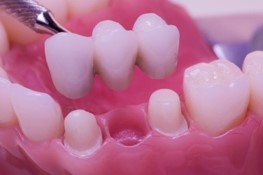
2 DAY PROCESS
A bridge is a fixed dental restoration used to replace one or more missing tooth by joining an artificial tooth definitively to adjacent teeth. A bridge will span the area where teeth are missing. They are attached to the natural teeth (called anchor).
The cost is based on each unit. A unit represents a tooth. The bridge will have a minimum of two anchor teeth. Typically, an anchor tooth on each side of the missing teeth/tooth.
Bridges: patients have two options for materials used to make the units on the bridge, either zirconia or porcelain fused to high noble metal (pfm).
Zirconia (zirconium oxide) is a white powdered metal used to create dental frameworks for crowns, bridges and other dental substructures. It creates the appearance of a whiter more translucent tooth and is transparent in x-rays. Zirconia has been in use in cosmetic dentistry for many years to achieve the most aesthetic result possible but has more recently become widely accepted as the dental material of choice.
Advantages of zirconia
- Zirconia crowns can be translucent enough to blend with other teeth and give a natural look. What’s more, if bonded to the teeth rather than being cemented with conventional dental cement, these crowns won’t display a black line at the gum line.
- Strength: where porcelain crowns are prone to chipping, zirconia crowns are almost indestructible.
- Durability: crowns made of zirconia are likely to last a lifetime.
- Less sacrifice of healthy tooth: since zirconia crowns can offer superior strength in less volume than crowns made of other materials, they can be made to fit even when not much space is available for porcelain build up.
- Biocompatible: zirconia is completely compatible to human body. Since it is inert, and the body does not reject zirconia, you need not worry about facing allergies or unfavorable reactions.
- Corrosion resistant: zirconia crowns are resistant to corrosion, which adds to their longevity factor.
Disadvantages of zirconia
- Abrasive effect: the toughness of zirconia crowns can have an abrasive quality, which causes friction against the root of the affected tooth as well as with other teeth.
- Decay under the crown: though these crowns are meant to last a lifetime, the decay underneath the crown my cause them to loosen and fall.
How to take care of a dental bridge
- Avoid chewing hard food, ice or candy. Any of these can cause damage to the bridge or the teeth that hold the bridge in place.
- Grinding your teeth can cause damage to the crowns on either end of the bridge. Use a prosthetic aid (night guard) to assist you in stopping if you grind in your sleep.
- Purchase a good quality dental water pic. Do not floss in the bridge area. Water pic will keep the area clean. Brush as usual.
- If you experience any pain or problems, have them checked by your dentist. After a short healing period you should not notice any pain. If you do it could be an indication that the bridge has a “high spot” or gums are not healing properly, causing swelling. Please schedule an appointment if pain or irritation occurs after 5 days.
